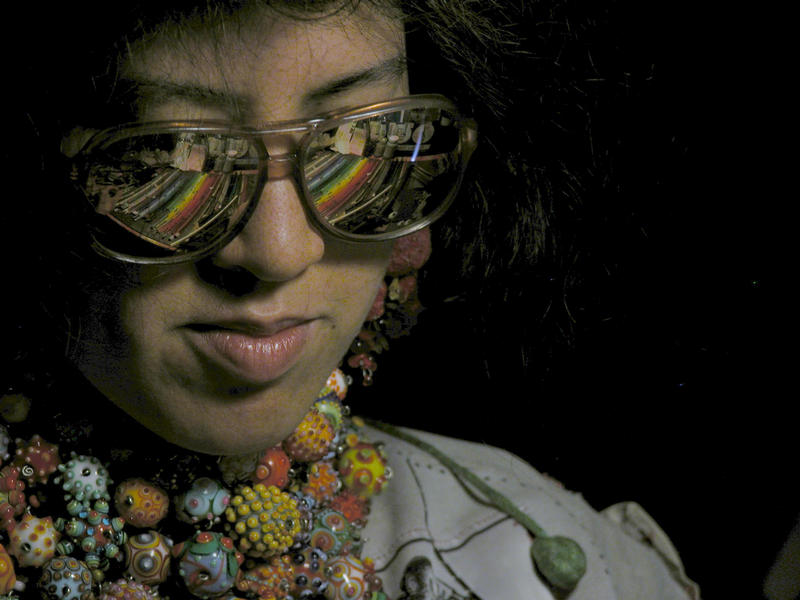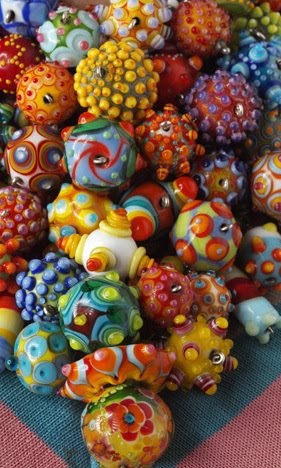
Though I make a lot of different things, flameworking (or lampwork or torchwork) is what I do the most to pay my rent. I want to teach a lot more but it's hard to break out of the cycle of applying for craft shows, and making production work instead of challenging myself more with the massively ambitious projects that have been ruminating in my mind for years-- not yet actualized.My schedule usually includes a lot of traveling to sell work. Now I'm so glad to be in the Fab Academy because I'm learning how to do things I've wanted to know for years, and it's requiring me to stay put here in Providence. This is my huge neck party, which has been evolving over 12 years. It doesn't get bigger anymore-- I just switch out beads as I make ones that I like more. I'm saving the old ones for a mosaic that I will one day make as a sink backsplash. The necklace is on a lattice of sterling silver and it's lined with silk on the back. I think it weighs 4 or 5 pounds.
This is my huge neck party, which has been evolving over 12 years. It doesn't get bigger anymore-- I just switch out beads as I make ones that I like more. I'm saving the old ones for a mosaic that I will one day make as a sink backsplash. The necklace is on a lattice of sterling silver and it's lined with silk on the back. I think it weighs 4 or 5 pounds. I taught myself lampwork by ordering a kit in the mail, "Everything You Need to Make Glass Beads" for $99. Pictured above is the Hothead torch that I started with and my hand for scale.(This is a special torch designed just for lampwork. I have some links to suppliers and educational resources on my website.)After learning with the kit I transferred from the Maryland Institute, College of Art to the Rhode Island School of Design, where I got a degree in Glass. Unfortunately, RISD didn't really teach torchwork, but I learned so much and I loved going to school there.
I taught myself lampwork by ordering a kit in the mail, "Everything You Need to Make Glass Beads" for $99. Pictured above is the Hothead torch that I started with and my hand for scale.(This is a special torch designed just for lampwork. I have some links to suppliers and educational resources on my website.)After learning with the kit I transferred from the Maryland Institute, College of Art to the Rhode Island School of Design, where I got a degree in Glass. Unfortunately, RISD didn't really teach torchwork, but I learned so much and I loved going to school there. The process is analogous to drawing in three dimensions, mid-air, with molten glass.
The process is analogous to drawing in three dimensions, mid-air, with molten glass.
 The 2 photos above were taken by Dave Fischer. I wear those didymium lens glasses to protect my eyes from the sodium flare of the flame. Who wants to burn out their retinas? A condition exists called "Glassblower's Cataracts." One can do damage from just one day of work, and it might not show up for 10 or 15 years! Staring into a gloryhole (a 2400 degree furnace) is a lot more intense than staring at a soft glass torch, but both can potentially be damaging if one isn't careful.
The 2 photos above were taken by Dave Fischer. I wear those didymium lens glasses to protect my eyes from the sodium flare of the flame. Who wants to burn out their retinas? A condition exists called "Glassblower's Cataracts." One can do damage from just one day of work, and it might not show up for 10 or 15 years! Staring into a gloryhole (a 2400 degree furnace) is a lot more intense than staring at a soft glass torch, but both can potentially be damaging if one isn't careful.

This is my desk, just before assembling pieces for a show.




















































